Sneak Peek: The Perelman Performing Arts Center
The Perelman Performing Arts Center invited the press to tour the site on Monday, and while it was a very gracious and informative tour — Tribecan and architect Joshua Ramus; architect David Rockwell, who designed the lobby and restaurant; and PAC leadership Khady Kamara and Bill Rauch led the tour — there were no pictures allowed! This was torture. The ones here are the only few they would share. But the fly-through video is excellent and the best way to acquaint yourself with the project’s complexity. If you are too impatient to listen to PAC board chair Mike Bloomberg take you through the history, start at minute 1 for the building of the site; minute 3 for an overview of the performance spaces.
The PAC is scheduled to open this September — my guess is they are aiming for Sept. 11. And while they did not talk about programming — that’s a topic for later this spring — the center is intended to show anything and everything: theater, opera, dance, music, film, etc. What we did talk about is the architecture and how it relates to programming, the restaurant from Marcus Samuelsson and the construction.
The PAC has been 20 years in the making: the project was first awarded to Frank Gehry in 2004 but then languished for a decade until an invited competition took place in 2014. Ramus and his firm REX won the gig. They said this was the final piece in the master plan for the World Trade Center, though of course 2 WTC and 5 WTC are still unbuilt.
The project cost was $500 million, and I assume they rounded down. Much of that is private, with $100 million from the Lower Manhattan Development Corporation. I think the original budget was $200 million.
So here goes:
THE ARCHITECTURE
The complexity of it all will either blow your mind, or, if you are like me and have limited capacity, will make your head hurt. The structure may look simple — it’s a box! — but don’t be fooled. It’s like an origami fortune teller — it can open several different ways and you never know what combination you’ll land on. “Every time a visitor comes it will be different,” Ramus said. “And the more times they use it the more confounded they will be.”
There are three auditoria (they have already been named by donors: the Mike Nichols, the Doris Duke and the John Zuccotti) ranging in size from 99 to 450, and the genius of the place is they can be combined into 50 different layouts using four massive guillotine walls and a complex of “Spiralifts,” retractable columns that allow the floor to rise and fall. That means a stage can be turned into risers for seating or vice versa. Pretty much everything in the place moves, save for the box seats around the perimeter. “It is the most beautiful piece of engineering,” Ramus said of the columns. “It’s like the marriage of a steel film strip with a toothed slinky.”
The result is they can create a small stage for 90 or a full Shakespearean theater in the round for 950.
The marble of course is the scene-stealer, chosen for its complex veining and creamy coloration which glows amber when lit from within at night, or lit from without during the day. It’s breathtaking and actually startling when you first see it. Lit from the outside by the sun it’s like each of the 4896 panels is a watercolor painting using the same palette over and over. Watch the video to understand how they worked the pattern, which was largely done to avoid changes in the marble as they quarried it over a couple years.
Each 5′ x 3′ panel is a half inch thick and laminated on both sides with non-glare glass so it doesn’t warp with exposure to the elements. (I think they should auction off the rejects.) I can’t wait to see the aluminum LED chandeliers at full strength.
“This building is such a gift for artists to think about what they want to do,” said Rauch, the artistic director. “Flexibility is a cool thing for a artist. And it gives audiences and opportunity to change their perspective on the world.”
THE LOBBY AND RESTAURANT
The first floor lobby will be open to the public for small performances and the restaurant will also be fully accessible to the public. You access both from elevators or the “grand staircase” that comes up from the memorial side of the building. Because of that approach, the ceiling is the first thing you see so it received extra-special attention, and it has a perforated metal panels with its own acoustics and ribbon-like lights running through and across like Tron. Emerging from between the lights are sculptural sapele wood features that draw the focus to certain spots — a performance area, the bar — that function like super mod chandeliers.
Read more about chef Marcus Samuelsson’s involvement here.
THE ENGINEERING
Of course nothing at the World Trade Center is simple. The building had to be reverse engineered since the construction of the PATH tracks run underneath it and since the entrance to the underground roadway that serves the entire WTC is at it’s north edge. There were only seven purchase points for them to use, so columns had to rise up between the tunnels to a platform for the base of the building. Plus the first 20 feet, all in black granite, are Port Authority property.
Our tour was almost two hours, and so much of that was mind boggling — for instance, the marble is not structural — it’s just a curtain wall — and the theaters inside are suspended. If the roof came off, the theaters could fly right out. The materials are incredible — not just the marble, but the lathed walnut walls, the Bordeaux velvet seating, the steel ceilings. I could go on, but I will wait for more when it opens.







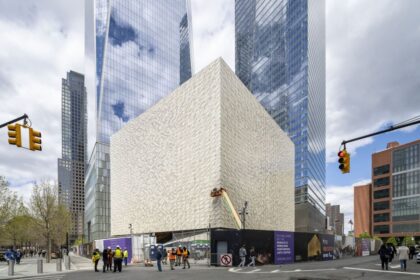

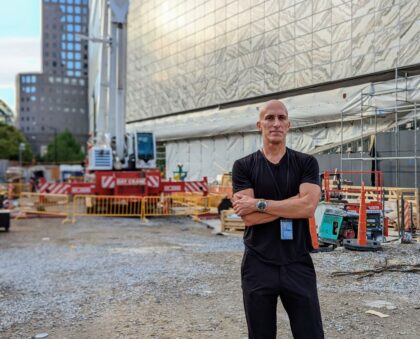
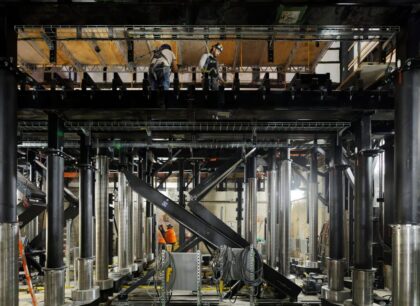
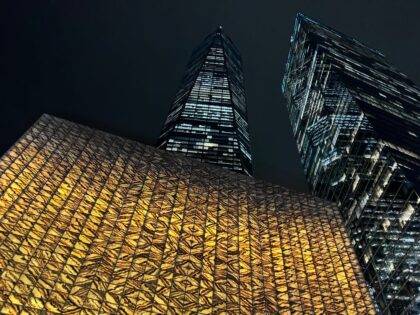
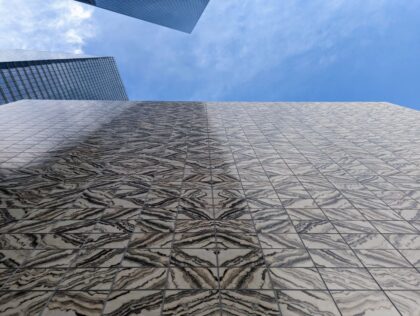






I can’t wait! I just hope they haven’t out-engineered themselves and end up with useless space because the mechanics don’t work like the Oculus roof.
Looks great! Thanks for the preview.
WOW!!
Amazing!! Thank you for this introduction!
Where have I been. I knew nothing about this performance center but so excited that it is now in our neighborhood.
This city has some fancy performance venues…but I wish more money would “trickle down” to the performers themselves. Without them…this is just a fancy box full of chairs. I’m more interested in finding out what I’ll be seeing and hearing programmed in that box than the box itself.
Downtown is sorely missing this kind of venue. This will be a huge benefit for the neighborhood and I am looming forward to seeing what programming is planned.
Exciting and long awaited! I hope when opening comes, they acknowledge and invite those who began this project and nurtured it for its first several key years: President Maggie Boepple, COO David Langford, Jenny Gersten, Lucy Sexton, and David Lan. The project never would have happened without them.
Fantastic! So glad to see this coming to fruition. Can’t wait to explore and see performances there.